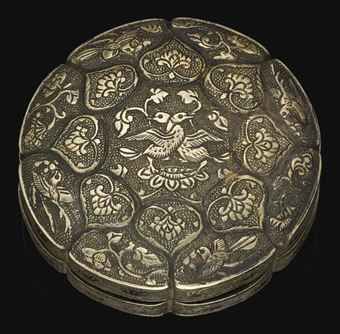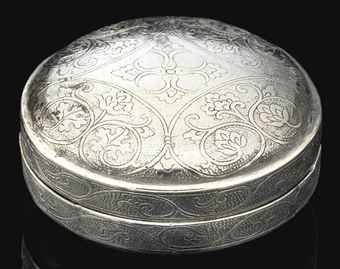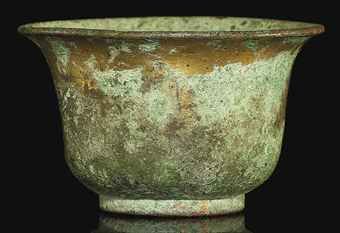Tang dynasty parcel-gilt silver, silver and gilt-bronze @ Christie's London
A magnificent rare parcel-gilt silver lobed bowl and cover. Tang dynasty (618-907). Photo Christies 2011 Ltd
The bowl divided into five lobes by raised ridges, each lobe superbly engraved and gilt with floral and fruit clusters amidst luscious foliage, the interior with a central medallion enclosing large blooms and fruit surrounded by feathery leaves, the gently everted rim engraved and gilt with a band of overlapping petals, the exterior mirroring the decoration to the interior, the gently domed cover with a central medallion enclosing flowering and fruiting clusters enveloped by feathery leaves, all encircled by five further clusters of flowering and fruiting branches, the rim finely detailed with floral scrolls; The bowl 9½ in. (24.2 cm.) diam., the cover 9 7/8 in. (24.9 cm.) diam., total weight 1206g. Estimate £400,000 - £600,000 ($668,400 - $1,002,600)
Provenance: By repute, acquired in Stockholm, Sweden, directly from Mr. Orvar Karlbeck between 1928-1930.
Literature: Orvar Karlbeck, Karlbeck-Konsortiet, Stockholm, Sweden, 1930-1931, Vol. I, p. 27, no. 146.
Notes: Karlbeck-Konsortiet were not widely spread publications, consisting of typed or mimeographed pages with photographs that were trimmed and pasted in next to the descriptions of the items. Such publications were compiled by Mr. Orvar Karlbeck, an engineer by profession, resident in China between 1906 and 1927. Mr Karlbeck had an excellent eye for the art and antiquities of China and was trusted by museums and private collectors back in his native Sweden and across Europe to source items that would be of interest to them.
In 1927 Mr. Ovar Karlbeck returned to Sweden as political stability in China started to deteriorate. Nevertheless, between 1928 and 1934 Karlbeck conducted three 'collecting' expeditions to China in order to buy objects for museums and private collectors. His first expedition in 1928 was conducted on behalf of the Museum of Far Eastern Antiquities in Stockholm and directed by J.G. Andersson. The two subsequent trips were conducted on behalf of the Karlbeck Syndicate, a consortium of museums and prominent private collectors which included the British Museum, the Berlin State Museum, H.M. King Gustaf VI Adolf of Sweden and George Eumorfopolous.
See Bo Gyllensvard, Chinese Gold, Silver and Porcelain, The Kempe Collection, The Asia Society, New York, 1971, p. 80, no. 56, where the author states: 'The piece (a bowl and cover virtually identical to lot 187) comes from one of three tombs found near Palin in Eastern Mongolia. From two of these, in 1930, Mr. O. Karlbeck obtained eight silver bowls, four similar to the present lot piece and four without covers'. The author also mentions that 'similar bowls are also in the M. Mansson Collection, Stockholm', which refers to the current lot.
Such magnificent partial-gilt silver bowls and covers are amongst the finest works of art produced during the Tang Period and there are a number of extant examples in public collections.
Two similar bowls with covers are in the Seattle Art Museum, Seattle, published by Paul Singer in Early Chinese Gold and Silver, China Institute, New York, 1971, no. 85. Two further bowls and covers are in the Pennsylvania University Museum, Philadelphia and published by Bo Gyllensvard, T'ang Gold Silver, B.M.F.E.A., Vol. 29, Stockholm, 1957, plate 21.
For another bowl and cover, formerly in the Carl Kempe Collection, see Bo Gyllensvard, Chinese Gold and Silver in the Carl Kempe Collection, Stockholm, 1953, pl. 115; the bowl and cover was subsequently sold at Sotheby's London, Masterpieces of Chinese Precious Metalwork: Early Chinese Gold and Silver, 14 May 2008, lot 74.
See also a bowl but without the cover and lacking the footring, in the City Art Gallery, Bristol, formerly from the collection of Robert C. Bruce and sold at Sotheby's London, The Well-known Collection of Important Chinese Ceramics, Jades and Bronzes, The Property of Robert C. Bruce, Esq., 12 May 1953, lot 21, where it was purchased by Lord Dulverton and presented to the current institution.
A very rare small lobed silver stem cup.. Tang dynasty (618-907). Photo Christies 2011 Ltd
The gently rounded body divided into eight lobes and supported on a short stem with a wide fluted lobed foot, delicately chased and engraved with ducks and parrots, some in flight, others alternately facing each other, all set in a landscape amidst rocks and trees, all reserved on a ring-punched ground, the base incised with an illegible character; 1¾ in. (4.5 cm.) high Estimate £20,000 - £30,000 ($33,420 - $50,130)
Provenance: By repute, purchased from Kusaka Shogado in Kyoto, Japan, in the 1930s.
From the Martin Mansson Collection
Martin Mansson (1880-1952) was a Swedish entrepreneur with early links to Russia and Japan. From 1911-1917 he lived in St.Petersburg where he owned a company selling high-quality Swedish stainless steel. In addition to learning the Russian language, he became interested in contemporary Russian art, and became acquainted with several painters, including Ilya Repin, and his students. His painting collection, numbering several dozen, was shipped back to Stockholm well before 1917, when he was obliged to return home.
Although he first visited Japan in 1907, it was in 1920 that he returned to the country to set up a sales operation similar to that in St. Petersburg which had been halted three years earlier. He spent several years in Osaka and Kobe, when his interest in Japanese works of art commenced. Once again he realized the benefit of learning the language in order to facilitate the acquiring of works of art. The result was a fine collection of woodblock prints, netsuke, inro, porcelain (in particular Kakiemon vases), swords, lacquer and silver.
It was in the 1930s, when back in Japan, that he extended his collection to include Chinese art. Fine porcelain, Tang silver, and Shang bronzes were his particular interests, and he studied these subjects both in books and through his discussions with his friend Kusaka Shogado, who was a leading dealer based in Kyoto, and from whom he made many purchases. Martin Mansson visited Japan for the last time in 1938, when he bought numerous items for his collection.
Notes: Compare a very similar eight-lobed stemcup formerly in the Carl Kempe Collection and illustrated by Bo Gyllensvard in Chinese Gold Silver and Porcelain: The Kempe Collection, New York, 1974, p. 57, pl. 54, where the author references the current cup, from the M. Mansson collection.
A very rare small parcel-gilt silver lobed circular box and cover. Tang dynasty (618-907). Photo Christies 2011 Ltd
The cover finely chased and engraved with a pair of confronted ducks standing on a lotus flower below foliage, surrounded by eight heart-shaped cartouches enclosing a single bloom, the rim with birds in flight alternating with floral clusters, the base with a pair of birds with entwined necks to the centre and similarly decorated, all reserved on a ring-punched ground; 2 in. (5 cm.) diam. Estimate £8,000 - £12,000 ($13,368 - $20,052)
Provenance: By repute, purchased from Kusaka Shogado in Kyoto, Japan, in the 1930s.
A small parcel-gilt silver circular box and cover. Tang dynasty (618-907). Photo Christies 2011 Ltd
The cover and base divided into eight lobes radiating from the centre, each lobed finely chased and incised, alternating with ducks and flowering shrubs, all reserved on a ring-punched ground; 1½ in. (3.8 cm.) wide. Estimate £6,000 - £8,000 ($10,026 - $13,368)
Provenance: By repute, purchased from Kusaka Shogado in Kyoto, Japan, in the 1930s.
A fine small circular silver box and cover. Tang dynasty (618-907). Photo Christies 2011 Ltd
Of gently compressed form, the cover and base chased and incised with eight panels radiating from a central flower, each containing birds in flight alternating with flowering shrubs, all reserved on a ring-punched ground, the sides incised with meandering scrolls; 1¾ in. (4.5 cm.) diam. Estimate £6,000 - £8,000 ($10,026 - $13,368)
Provenance: By repute, purchased from Kusaka Shogado in Kyoto, Japan, in the 1930s.
A small circular silver box and cover. Tang dynasty (618-907). Photo Christies 2011 Ltd
Chased and engraved on both the slightly domed box and cover with floral blooms borne on meandering tendrils, the narrow sides with small billowy clouds, all reserved on a ring-punched ground; 2 in. (5.1 cm.) diam. Estimate £5,000 - £7,000($8,355 - $11,697)
Provenance: By repute, purchased from Kusaka Shogado in Kyoto, Japan, in the 1930s.
A very rare small gilt-bronze cup. Tang dynasty (618-907). Photo Christies 2011 Ltd
The waisted body supported on a short tapering foot, finely chased and engraved with a meandering leafy scroll bearing small blooms, the short flaring rim similarly decorated, all reserved on a ring-punched ground, applied to one side with a delicate tabbed ring handle; 1 7/8 in. (4.7 cm.) high. Estiùate £4,000 - £6,000 ($6,684 - $10,026)
Provenance: By repute, purchased from Kusaka Shogado in Kyoto, Japan, in the 1930s.
A small circular silver box and cover. Tang dynasty (618-907). Photo Christies 2011 Ltd
Finely engraved and chased on the slightly domed cover and base with a central stylised bloom within a diamond-shaped panel, surrounded by further blooms borne on leafy scrolls, the sides with meandering scrolls, all reserved on a ring-punched ground; 1½ in. (3.8 cm.) diam. Estimate £3,000 - £4,000 ($5,013 - $6,684)
A very small parcel-gilt silver circular lobed box and cover. Tang dynasty (618-907). Photo Christies 2011 Ltd
The cover and base divided into six lobes, each finely incised with a stylised bloom picked out in gilt, all reserved on a ring-punched ground; ¾ in. (2 cm.) diam. Estimate £2,000 - £3,000 ($3,342 - $5,013)
Provenance: By repute, purchased from Kusaka Shogado in Kyoto, Japan, in the 1930s.
An unusual gilt-bronze cup. Tang dynasty (618-907). Photo Christies 2011 Ltd
Of inverted bell form with gently flaring rim, supported on a short foot, heavily covered in encrustation to interior and exterior; 2½ in. (6.4 cm.) diam. Estimate £1,000 - £1,500 ($1,671 - $2,507)
Provenance: By repute, purchased from Kusaka Shogado in Kyoto, Japan, in the 1930s.
Christie's. Fine Chinese Ceramics and Works of Art , 10 May 2011. London, King Street www.christies.com

/https%3A%2F%2Fprofilepics.canalblog.com%2Fprofilepics%2F1%2F0%2F100183.jpg)












/http%3A%2F%2Fstorage.canalblog.com%2F79%2F46%2F577050%2F66001994_o.jpg)
/http%3A%2F%2Fstorage.canalblog.com%2F40%2F54%2F119589%2F65372473_p.jpg)
/http%3A%2F%2Fstorage.canalblog.com%2F40%2F89%2F577050%2F63638297_o.jpg)
/http%3A%2F%2Fstorage.canalblog.com%2F16%2F89%2F119589%2F63248071_p.jpg)